Lipid membranes

Lipid Membrane Mastery Quiz
Test your knowledge on lipid membranes and metabolic processes with our comprehensive quiz! This interactive quiz consists of 35 carefully crafted questions that cover the intricate details of lipids, their fun
- Multiple choice and checkbox questions
- Instant feedback on your answers
- Perfect for students, educators, and health enthusiasts
Which statement correctly describes the structure of lipids?
Lipids enclose the aqueous cytosol of an animal cell in a monolayer.
Lipids are formed by addition of repeating subunits into a polymer.
Lipids all have a large hydrophobic region
Most lipids contain peptide bonds
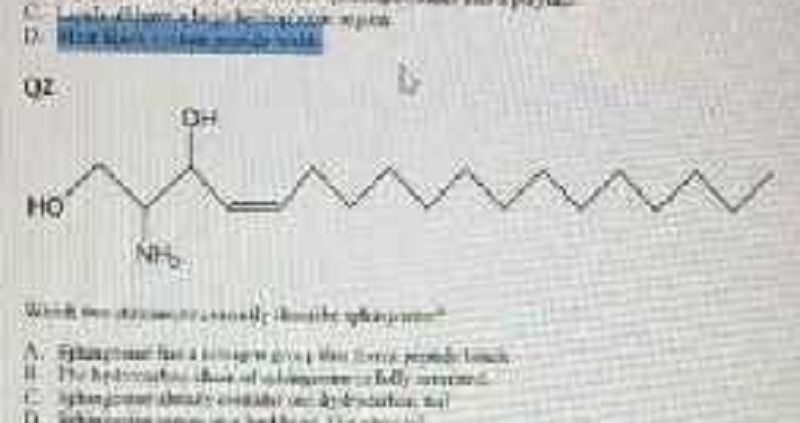
Which two statements correctly describe sphingosine?
Sphingosine has a nitrogen group that forms peptide bonds.
The hydrocarbon chain of sphingosine is fully saturated.
Sphingosine already contains one hydrocarbon 'tail'.
Sphingosine serves as a backbone, like glycerol
Sphingosine is an energy storage lipid.
Glycerol can form triacylglycerol when...
...three glycerol molecules react with one another.
...the acyl groups cyclize to form a multi-ring structure
...each ester linkage is replaced with a phosphodiester linkage.
...a fatty acid is esterified to each hydroxyl group of glycerol

Molecule A or molecule B will have more van der Waals interactions with its neighboring lipids. A high number of molecule A or molecule B is more likely to be liquid at room temperature.
1=A
1=B
2=A
2=B
What is the main function of triacylglycerol in animal cells?
Maintain plasma membrane fluidity
Store energy for the short term
Store energy for the long term correct
Compartmentalize organelles
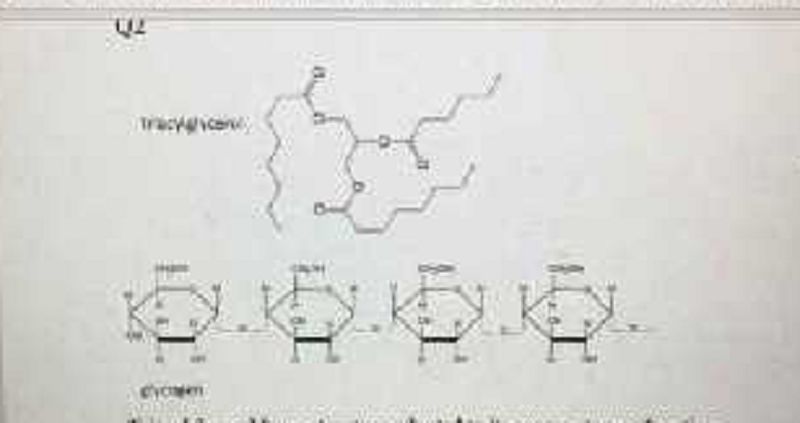
Triacylglycerol has a structure adapted to its energy storage function. The A. Repeating subunit B. hydrophobic C. Hydrophilic properties of triacylglycerol allow for A. Dense packing B. Spontaneous diffusion C. Rapid oxidation of carbons. The carbons of triacylglycerol are in a A. charged, B. Highly reduced, C. Partially oxidised, D. Activated form. Meanwhile, the carbons of glycogen are in a A. charged, B. Highly reduced, C. Partially oxidised, D. Activated form. form.
1=A og 2=B
Gram for gram, triacylglycerol has (1) energy density as compared to glycogen; however, glycogen is broken down (2)
Greater (1)
Equal(1)
Less(1)
in an unregulated manner (2)
More rapidly (2)
More slowly (2)
Which TWO of the following statements accurately describe the surface of a lipid droplet?
A monolayer of phospholipids
A bilayer of phospholipids
A network of perilipin protein
A structured layer of triacylglycerol
A chaotic hydrophobic/hydrophilic interface
Phospholipids are excellent for storing triacylglycerol because their (1), face the aqueous environment, while their (2) face the densly packed triacylglycerol.
Hydrophobic tails (1)
High energy phosphate groups (1)
Hydrophilic head groups (1)
Hydrophilic head groups (2)
Hydrophobic tails (2)
High energy phosphate groups face the densly packed triacylglycerol
How does sub-cellular localization regulate lipolysis in a stimulated adipocyte?
A chaperone carries triacylglycerol from a lipid droplet to the first lipase.
The first and second lipase need to be recruited to the lipid droplet to be active
The third lipase is sequestered on the surface of the lipid droplet while active.
The perilipin network is degraded to release triacylglycerol into the cytosol.
Match the three lipases of triacylglycerol metabolism with their modes of regulation. (1) is constitutively active in the cytosol. (2) is recruited to the lipid droplet based on a binding partner in the perilipin network. (3) is phosphorylated by PKA to facilitate recruitment to the lipid droplet.
The first lipase (ATGL) (1)
He second lipase (HSL) (1)
The third lipase (MGL) (1)
The first lipase (ATGL) (2)
the second lipase (HSL) (2)
the third lipase (MGL) (2)
the first lipase (ATGL) (3)
The second lipase (HSL) (3)
The third lipase (MGL) (3)
Which TWO steps describe hormone regulation of triacylglycerol metabolism?
Adrenaline signals an adipocyte to degrade its lipases.
Hormones bind a transmembrane receptor on the surface of the lipid droplet.
Catecholamines trigger a signaling cascade that activates a key kinase.
The sphingolipid monolayer of a lipid droplet is phosphorylated to form phospholipids.
The perilipin network rearranges to promote recruitment of lipases.
Q 6 er ikke med!
OK
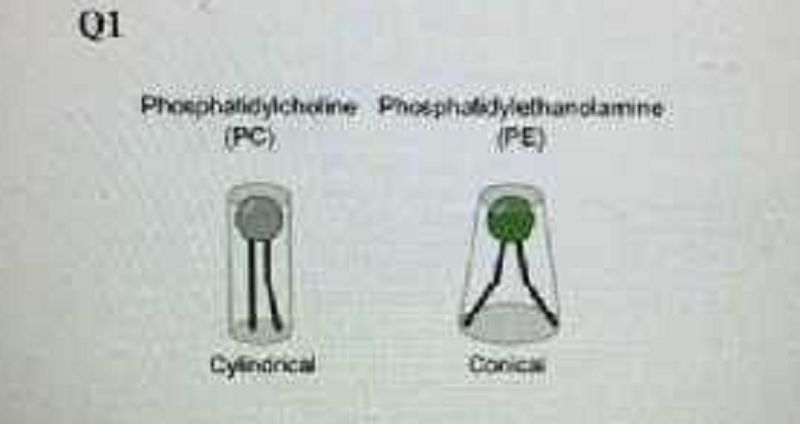
Of the phospholipids shown above, those with a (1) shape are more likely to be found in the outer leaflet of the membrane, while lipids with a (2) shape are more likely to be found in the inner leaflet
Cylindrical (1)
Conical (1)
Spherical (1)
Cylindrical (2)
Conical (2)
Spherical (2)
Match each protein to its activity. (1) moves lipids down their concentration gradient, in either direction. (2) moves lipids against their concentration gradient, from inner to outer membrane. (3) moves lipids against their concentration gradient, from outer to inner membrane. (4) activity promotes membrane compositional symmetry.
Flippase (1)
Floppase (1)
Scramblase (1)
Flippase (2)
Floppase (2)
Scramblase (2)
Flippase (3)
Floppase (3)
Scramblase (3)
Flippase (4)
Floppase (4)
Scramblase (4)
In what cellular compartment are most phospholipids synthesized?
In the endoplasmic reticulum correct
In the nucleus
In the golgi apperatus
In the cysotol
Sphingomyelin is synthesized in the lumen of the golgi apparatus and is transported to the plasma membrane by vesicles. Sphingomyelin will first be incorporated into the (A/B) of the plasma membrane.
A. Inner leaflet
B. Outer leaflet
Q 1 I 2.5.5 IKKE MED!
OK
After the membrane of a cell type or organelle type is isolated and dried, the percent mass of lipid versus protein will...
Correlate directly with the volume of the cell or organelle.
Reveal the abundance of protein in Schwann cells.
Vary according to the function of the cell or organelle
Generate the same ratio, regardless of cell or organelle type
The protein composition of a membrane reflects its function. For example, while red blood cells and photoreceptors both have a (1), of protein in their plasma membranes, red blood cells have (2) of protein while photoreceptor cells have (3)
High density (1)
Low density (1)
a greater diversity (2)
essentially one type (2)
a greater diversity (3)
essentially one type (3)
The lipid bilayer can contain both integral membrane proteins and peripheral membrane proteins. Match the protein type with its characteristics. (1) membrane proteins must have hydrophobic coils that pass through the core of the lipid bilayer. (2) membrane proteins can be covalently linked to a lipid that is inserted in the lipid bilayer. (3) membrane proteins can transduce an extracellular signal across the lipid bilayer. (4) membrane proteins can serve functions on the intracellular and extracellular surfaces of the lipid bilayer
Integral (1)
Peripheral (1)
Both types of (1)
Integral (2)
Peripheral (2)
Both types of (2)
Integral (3)
Peripheral (3)
Both types of (3)
Integral (4)
Peripheral (4)
Both types of (4)
What are TWO important reasons that water can diffuse across the lipid bilayer?
The concentration of water in biological systems is very high.
Water is polar and can hydrogen-bond.
Water molecules are very small.
Water is needed for reactions in the cytosol.
Water is bulky and hydrophobic.
How do ions such as sodium (Na+) and chloride (Cl-) cross the plasma membrane?
The ions are so small, they can diffuse across.
The ions are charged, and bind with water to diffuse across
The ions require integral membrane proteins to cross.
The ions require peripheral membrane proteins to cross.
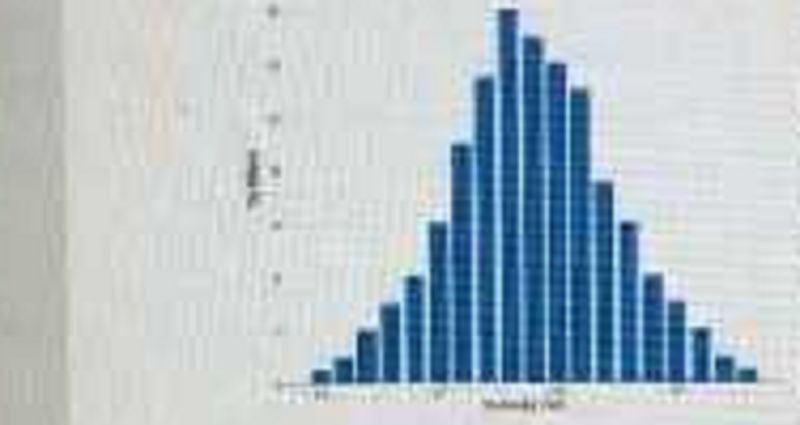
The figure below plots the % body fat of a sample of 5130 men. A patient of yours comes to office and is tested for body fat and is found to have 12% body fat.
.Too few lipid droplets?
Too many lipid droplets?
The right amount of lipid droplets?
Fill in the blank: Too few lipids can lead to ________.
Lipodystrophy and cachexia
Wasting disease
.various forms of cancer
None of the above
What do adipocytes require to maintain a healthy lipid level?
An excess amount of adipose tissue
An shortage of adipose tissue
Proper development, differentiation, and survival
None of the above
What is lipodystrophy?
Loss or failure to develop adequate amounts of adipose tissue for energy storage
An increase in the amount of adipose tissue in the body
Destruction of white blood cells
None of the above
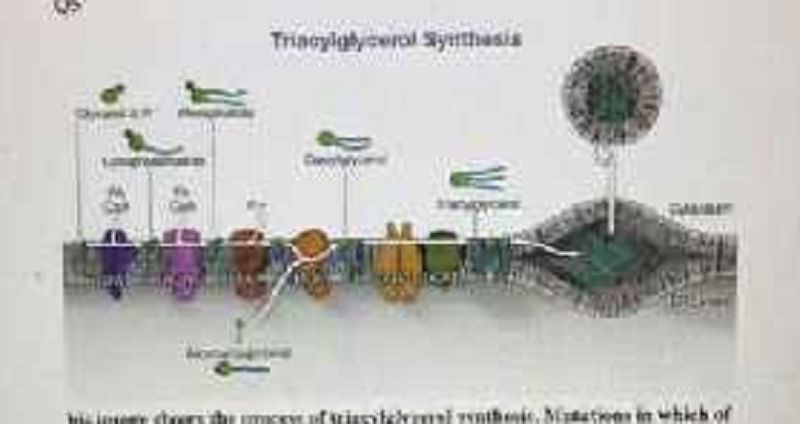
This image shows the process of triacylglycerol synthesis. Mutations in which of the enzymes shown are most often linked to lipdodystrophy?
Mutations in GPAT
Mutations in PAP
Mutations in AGPAT
Mutations in MGAT
What two key proteins are important for pre-adipocyte differentiation?
AKT2 and nuclear receptor PPARγ
PKA and the insulin receptor
Lamin A and ZMPSTE24
None of the above
Where is fat stored in a healthy individual? (Select ALL that apply.)
Inside the gut lumen
In a thin layer under the skin (the subcutaneous fat)
Inside the liver and other internal organs
Around internal organs
Primarily in muscle fibers
Which of the following is correct regarding adipocytes?
Adipocytes contain multiple small lipid droplets
Adipocytes contain one very large lipid droplet
The adipocyte nucleus is in the center of the cell
Adipocytes contain large amounts of glycogen
How does the body handle excess fat?
The body can only sequester excess fat by increasing the size of existing adipocytes
The body can only sequester excess fat by growing additional adipocytes
The body can sequester excess fat by increasing both adipocyte size and cell number
Which of the following diseases are associated with ectopic fat deposition? (Select ALL that apply.)
Cachexia secondary to cancer
Lipodystrophy resulting from antiretroviral therapy
Metabolic syndrome resulting from caloric imbalance
Neutral lipid storage disease, myopathy subtype
Which of the following statements is/are correct about cardiomyopathy and ichthyosis subtypes of neutral lipid storage disease? (Select ALL that apply.)
Both diseases are monogenic, meaning they result from the same ATGL mutation
Each disease results from a unique genetic mutation
Ichthyosis results from an unknown ATGL-independent function of ABHD5 that affects the skin’s lipid matrix
Cardiomyopathy results only from impaired cell signaling due to reduced ATGL function
Ox phos agonists are currently being developed to treat ichthyosis
Where does the fat accumulated in obesity originate from?
It originates strictly from dietary intake of fat
It originates from excessive ATGL activity due to a monogenic mutation
It originates strictly from dietary intake of carbohydrates and proteins which are then converted to fat
It originates from dietary intake of fat, carbohydrates, and proteins
{"name":"Lipid membranes", "url":"https://www.quiz-maker.com/QPREVIEW","txt":"Test your knowledge on lipid membranes and metabolic processes with our comprehensive quiz! This interactive quiz consists of 35 carefully crafted questions that cover the intricate details of lipids, their functions, and their significance in biological systems.Multiple choice and checkbox questionsInstant feedback on your answersPerfect for students, educators, and health enthusiasts","img":"https:/images/course8.png"}
More Quizzes
IV STANDARD GAME (ACS SCHOOL)
10548
Let's do Metabolism! Again
15849
Phanerozoic Eon
740
Paul Bunyan
13621
Should I Be a Manager? Find Your Perfect Style
201025623
Of Mice and Men: Can You Ace the Novel Test?
201034655
APH Belgium Human Name: Can You Get Them All Right?
201029491
Wedding Color: Discover Your Perfect Palette
201024522
Public Health Trivia Questions Challenge - Test Yourself
201027669
Think You're a Music Genius? Take This Musical IQ Test!
201032848
What's Your Mood Today? Free Mood Test to Reveal It
201023722
Free History Knowledge Trivia
201029491